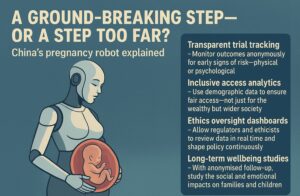At the 2025 World Robot Conference in Beijing, Dr Zhang Qifeng of Kaiwa Technology unveiled a concept that feels straight out of sci-fi: the world’s first humanoid robot capable of pregnancy—right from conception to delivery Interesting Engineering, Hespress.
Unlike neonatal incubators, this isn’t just a shell. It’s a lifelike figure with a built-in artificial womb. A foetus is placed into an environment filled with synthetic amniotic fluid and supplied with nutrients via a tube that mimics an umbilical cord The Economic Times, Hespress. According to Dr Zhang, the technology has matured in lab settings; now the goal is to integrate it into a humanoid—ready for real human-robot interaction The Economic Times, SAMAA TV.
A prototype is expected within a year or two, with a price tag under ¥100,000 (around US $14,000) New York Post, The Economic Times, Hespress. Already, discussions are underway with Guangdong Province officials to establish an ethical and legal framework New York Post, SAMAA TV, TESAA.
What’s Driving This—and Why It Matters
This technology could offer new hope to millions of infertile couples, giving an alternative path to parenthood without the medical risks of pregnancy New York Post, India Today. In countries like China, facing ageing populations and low birth rates, it may even become part of broader social policy efforts The Economic, Timesmint.
But such innovation raises major ethical questions:
-
Can a machine ever replicate the emotional bond that forms in utero?
-
Where do fertilisation, consent, and egg/sperm sourcing come into play?
- What are the psychological implications for children born this way? India Today, The Economic Times, Firstpost
How Ethical Data Insights Could Guide This Revolution
By harnessing well-governed data practices, this emerging technology could be deployed more safely and fairly—for the benefit of humanity:
-
Transparent trial tracking – monitoring outcomes anonymously could highlight early risks, whether physical or psychological.
-
Inclusive access analytics – demographic insights would ensure this technology isn’t reserved only for the wealthy, but can reach society more broadly.
-
Ethics oversight dashboards – giving regulators and ethicists real-time access to information would allow them to step in quickly and shape policy responsibly.
-
Long-term wellbeing studies – anonymised follow-ups could help us understand the social and emotional impacts on children and families over decades.
- Evidence-based policy – with reliable insights, regulation could be built on facts rather than speculation, improving both public trust and safety.
In essence, data governance moves this project from being speculative to responsible innovation, anchored in care, equity, and scrutiny.

#AIandEthics #ReproTech #DataForGood #Humanoid #InfertilitySolutions #Bioethics #FutureOfBirth #Tech4Humanity #EthicalInnovation
Source: Interesting Engineering – “China’s Kaiwa plans world’s first pregnancy humanoid robot” Interesting Engineering

Leave a Reply